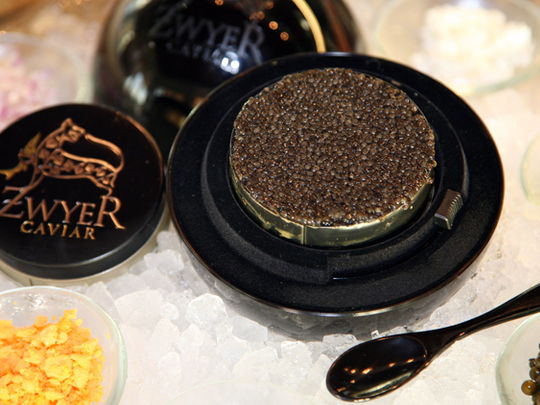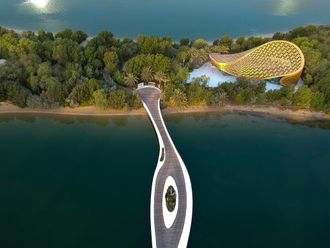
Caviar is a well-known luxury delicacy, consisting of salted, unfertilised sturgeon roe. But did you know it is the process behind producing the eggs that explains the hefty price tag?
In Pictures: Caviar - The luxury delicacy
The journey is long from the catching of the sturgeon to the opening of the tin can filled with well-arranged black eggs. The Terrace at Park Hyatt Dubai is the only restaurant in Dubai to serve Oscietra-type caviar from Russian and Siberian sturgeon, harvested exclusively on an aqua farm in Uruguay.
ZwyerCaviar is produced by Esturiones del Rio Negro (ERN), an independent family enterprise, which fertilises and raises the sturgeon in a habitat mimicking life in the Caspian Sea.
Imported guests
The three most important factors influencing the quality and taste of caviar are water, salt and nutrition. On the ecofriendly nature reserve in Uruguay, ZwyerCaviar's imported sturgeons are fed organic food (no pesticides) and live for up to ten years in a lake and artificial river system where they are washed with fresh water from the Rio Negro, one of the cleanest rivers in the world.
"We grow sturgeons in a conducive environment and this reflects on the quality of the caviar," said Steffen Gube, executive chef at Park Hyatt Dubai.
ZwyerCaviar's mid-sized grain comes from Russian and Siberian sturgeon and is of the Oscietra Flor de Sal Malassol (Russian word for "lightly salted") type. Its production is unique in that it uses sea salt, or Flor de Sal from Portugal for preservation, a novelty in the production of caviar.
"It's Oscietra caviar but its colour is close to that of Beluga," said Gube, referring to the most expensive category of black eggs, which range from light grey to black and are bigger than Oscietra and Sevruga roe. ZwyerCaviar roe are harvested when they are mature, in terms of size, taste, colour and consistency.
Presentation is important when it comes to caviar. ZwyerCaviar comes in sleek black round containers served on a bed of ice, with specific condiments — shallots, chives, yellow eggs, white eggs, crème fraiche and capers. Although caviar lovers tend to eat it as it is, most people enjoy it on blinis and toasts with, condiments. The golden rule when eating caviar is to use a mother-of-pearl spoon, although spoons made of horn, bone and wood may also be used, since metals have a negative effect on its taste.
"Leave it in your mouth, roll your tongue a bit and then swallow," Gube said.
According to Gube, the present prices of caviar range from Dh1,980-2,480 per kg. At The Terrace, ZwyerCaviar is priced at Dh250 for 10g or Dh2,995 for 125g.
The main criteria for good caviar are size, firmness and natural taste. "Good caviar should roll, taste slightly nutty and pop in the mouth. Caviar with a fishy smell is considered inedible," said Claudia Boucher, manager of Caviar et Prestige, which produces Sturia caviar. The Sturia hatcheries and breeding farms are located in Southwest France near Bordeaux, through which the Gironde estuary runs.
On the wild side
Wild caviar production has survived only in Iran, as Russia maintains a self-imposed ban on caviar trade from wild sturgeon. As a result, sturgeon aquaculture is popular in many countries, especially France, Italy, Germany and the US.
Caviar is expensive because it takes a long time to produce and calls for a huge financial investment.
Aqua farms have indoor- and outdoor-regulated lakes and ponds where imported sturgeons feed and grow for two years. The sex of the sturgeons is determined through ultrasound, as caviar is only produced from female roe. The fish grow for three to five years more, before farmers do a biopsy (by stunning the fish) to extract and taste the roe, still unfertilised.
The eggs are separated from the membrane and cleaned with tweezers and rinsed well.
Most commercial fish farmers extract the caviar from the sturgeon surgically and stitch up the wound to keep the sturgeon alive, allowing the females to continue producing more roe during their lives.
Humane methods
Other farmers go a step further and use a process called "stripping" to extract caviar without surgical intervention.
This is the most humane approach towards fish that is presently available but not all farmers can do it because they lack the expertise and technology.
Then comes the preserving process and the adding of salt following various methods — malassol, or lightly salted, salted with 3-3.5 per cent salt, pressed or pasteurised. Then the caviar is packed in tin cans. Between 600g and 1kg of caviar is produced per catch.
Recipe:
Potatoes with caviar(Servings: 6)
- 24 potatoes, small
- 4 tbs fresh cream
- 50g of caviar per person
Wash and peel the potatoes. Cook in barely boiling water, then leave to cool. Make a little hollow in each potato. Brown the potatoes in olive oil in a non-stick frying pan. Lay on a paper towel. Place a little fresh cream and a little caviar in each hollow and serve.
The history of caviar
The origin of caviar is disputed but references to the black pearls date back to ancient times when Phoenician, Egyptian and Roman coastal populations began to salt and pickle sturgeon eggs. Iranians coined the term chav-jar, or "cake of power," as they considered caviar to be a stimulant that increased their endurance and force. They were the first population known to consume sturgeon eggs, benefiting from the incredible resources provided by the Caspian Sea and its nearby rivers.
Following the great commercial routes of Central Europe, caviar made its first appearance at the Russian court, quickly becoming the preferred delicacy of their royal czars. Caviar slowly acquired popularity in Europe, where it became a delicacy of aristocrats.
The sturgeon of the Caspian Sea has suffered from overfishing, pollution and poaching and thus is at risk of going extinct. The annual catch is of about 1,000 tonnes of sturgeon (equal to about 100 tonnes of caviar), so in 1988, the sturgeon gained protection as endangered species and trade was regulated. The regulations concerning the bans have changed through the years but there is a limit on sturgeon harvesting and trade.
In 2006, the Convention on International Trade in Endangered Species, a UN agreement, placed a ban on the export of caviar by Russia, Kazakhstan, Turkmenistan and Azerbaijan (not Iran) but black market trade and poaching still occur in the region. Similarly, different types of sturgeons are native to the US but some are under threat, including white sturgeon which is now rare. As a result, farmed caviar and other alternatives are increasingly popular today.
Caviar classification
There are many types of caviar and one of the ways of classifying caviar is by fish source. While caviar is extracted from non-fertilised sturgeon roe, the alternatives come from other types of fish such as paddlefish, trout and salmon.
Three types of sturgeon that come from the Caspian and Black seas produce the best caviar.
Beluga
This is the best and most expensive caviar with its soft and large eggs. It's a product of the Huso huso species of sturgeon. Today, only about 100 Beluga sturgeons are caught in the Caspian Sea but they can also be found in the Black Sea and less frequently in the Adriatic Sea. Known to be the largest sturgeon, it can measure up to six metres in length and up to 25 per cent (and sometimes 50 per cent) of its body weight is attributed to eggs. The colour of Beluga caviar ranges from light grey to black. The lighter shades, which come from more mature fish, are in high demand.
Oscietra
This caviar is the product of the Acipenser gueldenstaedtii species of sturgeon, which can weigh up to 200kg and can grow up to two metres long, although the average weight is 20-80kg. Thus, it is smaller than Beluga caviar and produces medium-sized eggs. The Oscietra surgeon attains maturity anywhere between 12 and 15 years. Its average lifespan, is about 50 to 80 years. The eggs come in different sizes and colours ranging from gold and white to dark grey, black and dark brown. The flavour is also varied, depending on what the fish eats. It is firmer when compared to the Beluga caviar.
Sevruga
This caviar, a product of the Acipenser stellatus species of sturgeon (often called Starry sturgeon), follows in rank with its smaller greenish grey or grey-black eggs. It is intense in flavour and more affordable than the Oscietra and Beluga caviars. Its price is reflective of the fact that the Sevruga sturgeon, rarely weighing more than 25kg, is rather common and also quick to reproduce. The female Sevruga reaches maturity earlier than other sturgeons and produces eggs between the ages of 7 and 8. About 10 to 12 per cent of its body weight is attributed to roe.
Caviar substitutes
Roe from paddlefish, lumpfish, salmon, whitefish and hackleback can only be called caviar if the name of the fish is included in the title.
Paddlefish caviar, a popular variety, has glossy beads in different shades of grey and sometimes golden brown, and is sometimes called American caviar.
Hackleback caviar, with its black roe, is sweet, buttery and nutty in flavour.
Salmon caviar, from medium to large bright reddish or golden orange eggs, is popular among sushi chefs.
Whitefish caviar has small roe ranging from golden orange, red or black, with a crunchy texture and is sometimes infused with other flavours.
Lumpfish caviar, whether red or black, is an affordable option. It is pasteurised and has a crunchy texture.
Nutritional values of caviar
Consisting of fish roe and salt, caviar is a good source of calcium, phosphorus, protein, selenium, iron, magnesium and vitamins B12, B6, B2, B44, C, A, and D.
It contains the amino acids arginine and histidine, besides the essential amino acids lysine, isoleucine and methionine.
A tablespoon of caviar contains a gram of omega-3 fatty acids, which prevent heart disease. Although it contains many nutritional elements, it is high in sodium and cholesterol. Therefore, the recommended serving size is 30-50g per person.
Facts about caviar
- Caviar is consumed either with plastic or horn spoons as metal or silver has a negative effect on the taste
- Light caviar is more expensive than dark caviar
- Pearly quality, size, lack of colour and sheen of the grains are characteristics of good caviar
- Caviar is very rich in protein (25-30 per cent)
- Caviar contains good cholesterol
- Caviar is eaten either on its own or on blinis, with "Gschwellti" or egg but never lemon and mayonnaise
- If caviar smells sour, sweet or fishy, it is inedible
- Russia and Switzerland have the highest per capita consumption of caviar in the world







